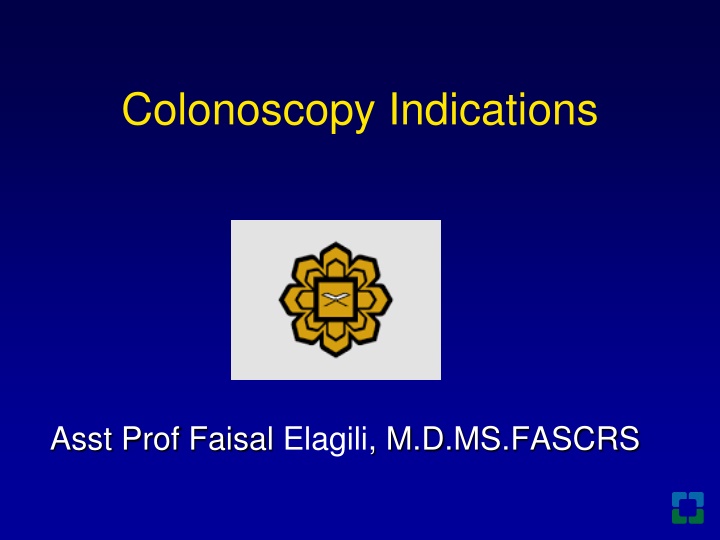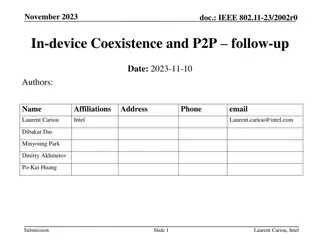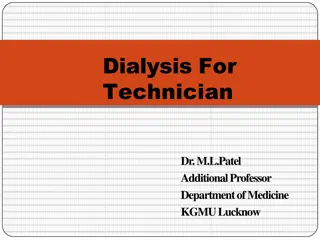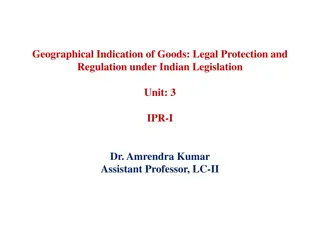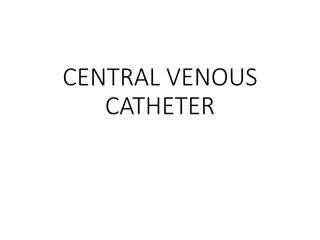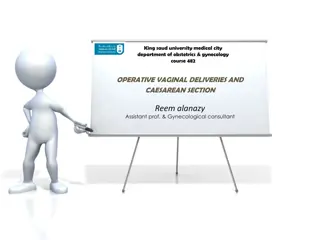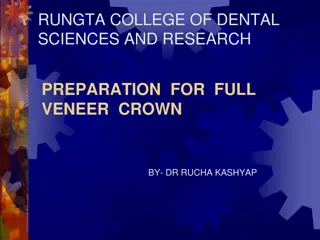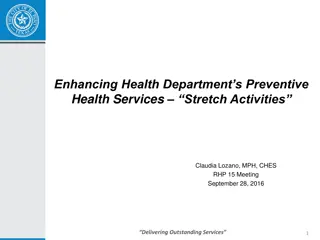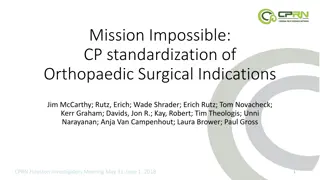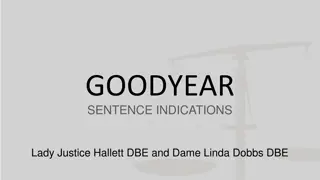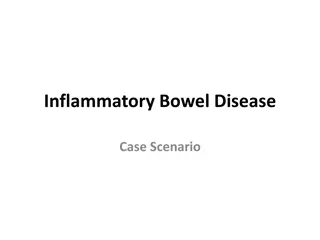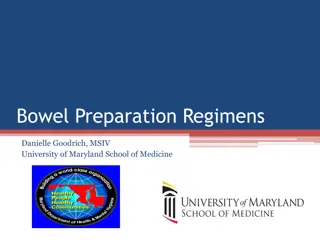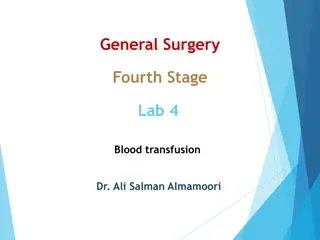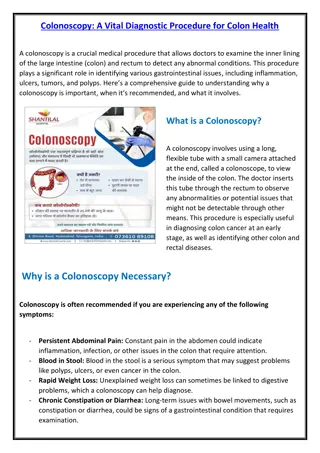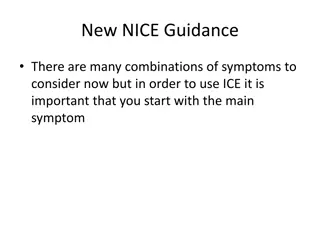Colonoscopy Indications
Colonoscopy is a procedure used to examine the large bowel for various medical purposes. It is indicated for diagnosing conditions like colorectal cancer, polyps, and inflammatory bowel diseases, as well as treating issues such as bleeding and stenosis. However, there are both absolute and relative contraindications that need to be considered before performing a colonoscopy. Patient preparation includes factors like medication adjustments and ensuring informed consent. Understanding the indications and contraindications is crucial for the safe and effective execution of colonoscopy procedures.
Download Presentation

Please find below an Image/Link to download the presentation.
The content on the website is provided AS IS for your information and personal use only. It may not be sold, licensed, or shared on other websites without obtaining consent from the author.If you encounter any issues during the download, it is possible that the publisher has removed the file from their server.
You are allowed to download the files provided on this website for personal or commercial use, subject to the condition that they are used lawfully. All files are the property of their respective owners.
The content on the website is provided AS IS for your information and personal use only. It may not be sold, licensed, or shared on other websites without obtaining consent from the author.
E N D
Presentation Transcript
Colonoscopy Indications Asst Prof Faisal Elagili, M.D.MS.FASCRS
Colonoscopy Colonoscopy is an examination to inspect the inner lining of the large bowel (rectum and colon) using a flexible tube with a camera at its tip. It is inserted via the anus and gently guided to the start of the large bowel (caecum).
Indications 1. 2. Lower GI bleeding Screening and surveillance of colorectal polyps and cancers a. Colon cancer b. Surveillance after polypectomy c. Colorectal cancer post-resection surveillance d. Inflammatory bowel diseases Acute and chronic diarrhea Therapeutic a. Excision and ablation of lesions b. Treatment of lower GI bleeding c. Colonic decompression d. Dilation of colonic stenosis e. Foreign body removal 5.Miscellaneous a. Abnormal radiological examinations b. Isolated unexplained abdominal pain c. Chronic constipation d. Preoperative and intraoperative localization of colonic lesions 3. 4.
Contraindications Absolute contraindications 1. Patient refusal 2. Uncooperative patients 3. Inadequate sedation 4. Known or suspected colonic perforation 5. Severe toxic megacolon and fulminant colitis 6. Peritonism 7. Severe coagulopathies 8. Acute diverticulitis Relative contraindications 1. Very large abdominal aortic aneurysms (particularly if they are symptomatic) 2. Patients who are immediately postoperative 3. Clinically unstable patients 4. Recent myocardial infarction or pulmonary embolism 5. Pregnancy
Patient Preparation Signed informed consent Routine laboratory testing is not necessary Oral iron therapy and bismuth-containing medications must be discontinued Constipating medicines should be stopped 48 hours Blood pressure medications are usually administered on the day of the procedure.
Patient Preparation Patients on beta blocker are more susceptible to intraprocedural bradycardia, and atropine should be available during the procedure Aspirin,antiplatelet and NSAIDs Diagnostic endoscopy with biopsy appears to be safe Therapeutic
Patient Preparation Chronic anticoagulation Diagnostic without biopsy May be performed as long as the international normalized ratio (INR) is maintained in the therapeutic range of 1.5 to 2.5 Therapeutic Low thrombotic risk Warfarin therapy is discontinued 5 days High thrombotic risk Warfarin should be temporarily discontinued 5days Low molecular weight heparin LMWH
Clear Liquid Diet Colonic preparation is improved by a clear liquid diet for one day before the colonoscopy Beverages: coffee, tea. Desserts: Jello, clear popsicles Fruit: Apple juice, cranberry juice, grape juice Soups: clear broth Sweets: hard candy, sugar.
Colonic preparation Fleet Phospho-soda 45 cc evening prior to and on the day of the procedure 4 6 hours before colonoscopy Relatively contraindicated in patients with renal insufficiency Polyethylene glycol (PEG) Patients must drink all 4 liters of prescribed PEG solution to adequately cleanse the colon Contraindicated in patients with suspected complete GI obstruction, and in patients with fluid overload
Patient Preparation Antibiotic prophylaxis In high-risk patients (eg, those with prosthetic valves, a previous history of endocarditis, complex cyanotic congenital heart disease, surgically constructed pulmonary shunts or conduits, or joint replacements) The most commonly used preprocedure and postprocedure prophylaxis regimens are as follows: Ampicillin or amoxicillin, 2 g IV/IM or 1.5 g orally Gentamicin, 1.5 mg/kg Vancomycin, 1 g IV
Sedation Versed and Fentanyl Continuous monitoring Reversal if needed
Colonoscopy Inseration Technique There are 6 major concepts 1. Keep the colonoscope straight. 2. Torque steering of the instrument shaft. 3. Position change and abdominal pressure. 4. Minimize gas insufflation 5. Avoid push unless you know where the tip is going. 6. Never let the left thumb leave the up/down dial.
Colonoscopy Inseration Technique The endoscopist tests all instrumental ports and manual controls before instrument insertion Left lateral position The anal area inspection Digital rectal examination The instrument tip, supported by the forefinger, is pressed gently and obliquely against the external sphincter until the sphincter relaxes, and inserted blindly a few cm into the rectum
Colonoscopy Inseration Technique This insertion may produce a red-out Colonoscopic advancement is deliberate with the lumen in view Mucosal surfaces are meticulously inspected, particularly areas behind folds, around flexures, and within regions of diverticulosis. Air insufflation is used sparingly Excessive air insufflation can precipitate instrument looping
Colonoscopy Inseration Technique Splenic flexure intubation Aided by Clockwise torque of the instrument shaft With external splinting of the sigmoid colon by the endoscopy assistant. After intubating this flexure, the tip of the instrument can be hooked onto the transverse colon wall, and the shaft modestly withdrawn to reduce any sigmoid loop and straighten the instrument
Colonoscopy Inseration Technique Hepatic flexure intubation Advanced using clockwise torque while the endoscopy assistant supports the midtransverse colon to prevent looping Colonoscopic suction helps maintain tip position within the colon during brief shaft withdrawal To help intubate the cecum The patient can be turned from the left lateral to the right lateral position to use gravity to advance the colonoscopic tip Air can be aspirated from the ascending colon to shorten its length
Colonoscopy Inseration Technique Cecal intubation is critical to complete colonoscopy and not miss a proximal colonic lesion. Appears as a closed capacious sac, bounded distally by the prominent ileocecal valve, and bounded proximally by the convergence of the curvilinear impressions formed by the three taeniae coli ( Mercedes Benz sign) at the caput (apex) of the cecum. The appendiceal orifice may be visible near the caput. It appears as a small dimple-like depression, surrounded by a small fold or slightly raised circular mound.
EXTUBATION TECHNIQUE Close examination of the colonic mucosa is best done during extubation Minimum withdrawal time of 6 min is required to gain an adequate ADR The key points to remember are as follows 1. Inflate enough to get clear views (then aspirate once a segment has been examined). 2. Rotate fluid to the 6 o clock position so it is easily and accurately suctioned. 3. Take care to examine behind flexures and folds. 4. Reinsert the colonoscope if you fall back too quickly to avoid missing sections of mucosa. 5. Consider using position change to optimize the view.
The Final Step-Retroflexion Fully inflate the rectum, and then manipulate the shaft gently into a U-turn position; using the lateral wheel Rectum or possibly the cecum, where the colonic lumen is widest Dangerous in a segment with diverticulosis
The Final Step-Retroflexion Useful to detect distal rectal pathology,including internal hemorrhoids, anal fissures, condyloma acuminata, and distal rectal tumors
The difficult colonoscopy One in which the endoscopist struggles or fails to reach the cecum Factors Loops or angulation in the colon Diverticular disease The quality of the preparation The patient s body habitus Abdominal hysterectomy Female
The difficult colonoscopy Failure to advance when lumen is visualized is usually caused by a colonic loop Mucosal trauma Abdominal pain from colonic stretch. Loops most commonly form in the sigmoid, descending, or transverse colon.
The difficult colonoscopy A loop is often reduced by Suctioning air Torque in the opposite direction from the loop Jiggling the colonoscope back and forth Patient repositioning Modest colonoscope withdrawal Right turn/left turn shortening
The difficult colonoscopy Loop reduction is indicated by Restoration of a one-to-one correspondence between colonoscope shaft and tip movements Amelioration of the patient s pain Loops are prevented by Suctioning excessive air Turning the colonoscope tip using torque External splinting of the colon by the endoscopy assistant Jiggling the colonoscope back and forth to pleat, shorten, and straighten the colon over the colonoscope
The difficult colonoscopy Slide-by maneuver The endoscopic tip is advanced, without visualization of colonic lumen, to negotiate a sharp turn. When the direction of the lumen is known and the colonoscope tip is turned in this direction Contraindicated in an area of Diverticulosis Stricture Active colitis Colonic mass
The difficult colonoscopy Successful slide-by is indicated by rapid passage ( spinning ) of mucosa across the colonoscopic lens without colonic resistance to colonoscopic advancement until lumen reappears Unsuccessful slide-by is indicated by arrest of mucosal motion across the lens, colonic resistance to colonoscopic advancement
The difficult colonoscopy Tricks to increase cecal intubation rates Limit the air used on intubation, or to suction air when encountering difficult angulation Changing the position of the patien When too much loop has been left in the colon and the cecum cannot be reached, the solution is sometimes to withdraw the endoscope,take out the troublesome loop, and reintubate the colon with great care Use of a thinner endoscope, such as a pediatric colonoscope
Colonoscopy Risks Perforation 0.1% Hemorrhage (polypectomy),0.1%-0.6% Cardiovascular and pulmonary complications related to sedation 0.9% Transient bacteremia after colonoscopy, with or with polypectomy Postpolypectomy electrocoagulation syndrome 0.003% to 0.1% Explosive complications of colonoscopy are rare Abdominal distention and pain
